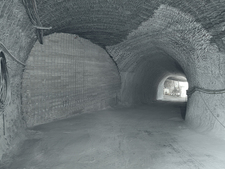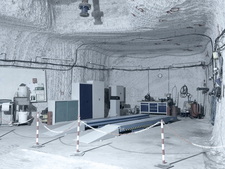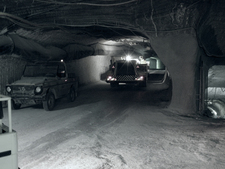Repair of the spiral drift underground
The Federal Office for Radiation Protection (BfS) blocked the spiral drift below and above the road junction in a depth of 637 m in March 2012 as a preventive measure. Before this measure was taken, experts of the Asse-GmbH had discovered cracks in the lane and in the rock adjoining the spiral drift.
Since it was not possible to repair the damaged spiral drift in a depth of 637 m on account of the deep cracks in the roof and the lane, new spiral drift sections were built for the blocked area. The first diversionary drift for the spiral drift was completed in August 2012. Since March 2013 the repaired spiral drift has been cleared for operation. Carrying out the repair took about one year and works could resume three months earlier than had been expected.
Spiral drift connects levels in depths between 490 and 850 m
The spiral drift is the drift that connects the levels in depths between 490 and 850 m. Miners use the spiral drift to drive to their underground work places and to transport work materials and equipment. Besides, the spiral drift serves as escape route in both directions, e.g. in case of fire.
The blocking of the spiral drift made regular mining operations more difficult. Therefore, the Asse-GmbH, the BfS and the Landesamt für Bergbau, Energie und Geologie (LBEG) began to repair the spiral drift immediately and in close co-operation with each other.
Construction of two diversionary drifts

![]() On the right-hand side there is the diversionary drift which has already been completed for the blocked spiral drift area (left-hand side)
On the right-hand side there is the diversionary drift which has already been completed for the blocked spiral drift area (left-hand side)
As a first step an escapeway was drilled for the blocked drift section. Furthermore it was decided to mill two diversionary drifts for the spiral drift into the salt, which are 70 m and 100 m long.
Since the damaged spiral drift in a depth of 637 m could not be repaired because of the deep cracks in roof and lane, a 70 m long diversionary drift had to be milled into the salt at the damaged part of the drift. Over a length of 50 m, the damaged spiral drift was completely covered with Sorel concrete. The Asse-GmbH concluded this work in August 2012.
As soon as the licence had been granted, works on the drift located above the damaged area of the spiral drift were taken up. Here, too, a 100 m long diversionary drift needed to be milled. The old track was covered completely with Sorel concrete and secured over a length of 80 m.
Mining operations continued

![]() Temporary workshop in a depth of 800 metres
Temporary workshop in a depth of 800 metres
To be able to continue the backfilling of roof clefts in the area of the diversionary drift, a connection to the accompanying drift of the mine workings had to be milled additionally.
Workshop areas for the maintenance and repair of vehicles and machines have been established on the 800-m level for as long as the remediation works of the spiral drift will last. This will make it possible to continue smooth mining operation.
Mining operation continued for the duration of the work and under the existing conditions.


